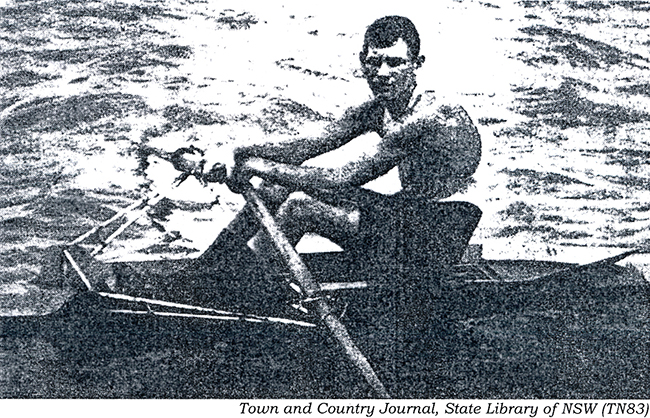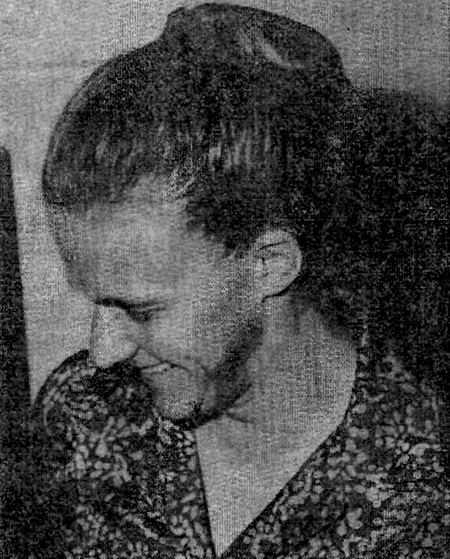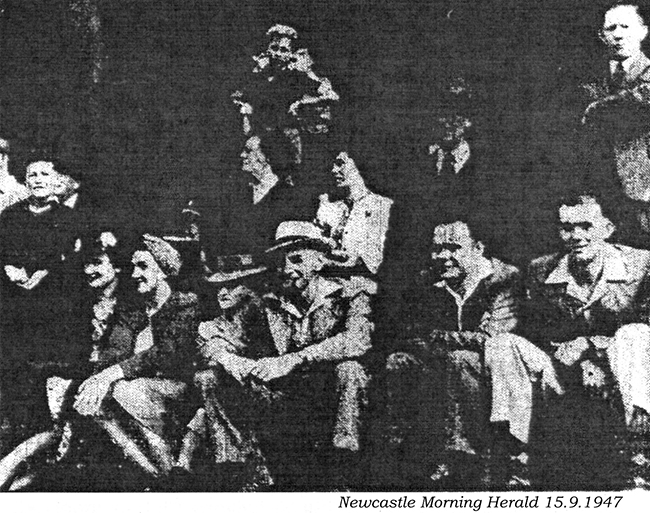History of Newcastle Rowing Club
Part 3 -Twentieth Century Rowing in Newcastle
Part 3 pages: 1, 2, 3, 4, 5, 6
Introduction
A decline in professional rowing that commenced in the late 1800s was replicated within rowing generally during the first half of the 20th century. As mentioned previously, the advent of the motor car and motor boat meant that, except for competition, rowing virtually died out. This was exacerbated by people being drawn to an ever increasing number and variety of sports and recreational pursuits. Community regattas petered out with fewer and fewer rowing events.
Certainly, these were serious blows but fortunately they were not fatal. Competitive rowing persevered within clubs and schools that were able to both maintain the sport at the grass roots level and showcase the sport through high profile events such as inter-colonial contests, state and national championships and the Empire, Commonwealth and Olympic Games.
Indeed, Australian rowers, amateur and professional, continued to excel on the international stage. Three of the best amateur scullers at international level, not forgetting that they were very successful domestically, were:
- Henry "Bobby" Pearce was the best of his family's three generations of champion rowers. He won the gold medal at the 1928 Olympics where he is said to have stopped rowing in one race to let a family of ducks pass before reclaiming the lead. He then won two Diamond Sculls at Henley, the first Empire Games sculling title in 1930 followed by his second Olympic gold medal in 1932. He turned professional in 1933, won the world sculling championship the same year then remained undefeated until relinquishing it in 1948.
- Mervyn Wood won a gold medal at the 1948 Olympic Games, a silver at the 1952 Olympics, gold medals in 1950 and 1954 Commonwealth Games, won the Diamond Sculls at Henley in 1948 and 1952 and the Philadelphia Gold Cup in the US in 1950. In Double sculls, Wood and Murray Riley won the 1950 and 1954 Commonwealth Games, a bronze medal in the 1956 Olympics. He also won a silver medal with Stuart McKenzie at the 1958 Commonwealth Games.
- Stuart McKenzie won the Diamond Sculls at Henley every year from 1957 to 1962 inclusive. In 1957 McKenzie was also champion of Australia, New Zealand, Belgium, England and Europe. He was Commonwealth Games Champion in 1958 and won a silver medal in the single scull at the first World Rowing Championships in 1962.
During this period, Australian professional scullers continued to emulate their illustrious predecessors by regularly winning the world professional sculling championship. Obviously, there was George Towns (1901-05) and (1906-07). He was followed by A Felton (1919), James Padden (1922-1925), Major* Goodsell (1925-27), Bobby Pearce (1933-48) Evans Padden (1948-49), G Cook (1949) and Max Fisher (1957). ['Major' was Goodsell's name, not a rank. Obviously his parent's aspirations for their son weren't too high].
Rowing in Newcastle
George Towns' win and retention of the world sculling championship title undoubtedly helped sustain Newcastle's interest in rowing longer than was the case in many other centres. In 1906 for instance, a number of prominent rowers such as the Towns brothers, Thoroughgood, George Stanbury, and Charlie Towns and several of the best locals such as Warboys, trained at Raymond Terrace in preparation for forthcoming races. On some weekdays steamers would go up the river from Newcastle full of people just in the hope of seeing their favourites in training.
Commencing in 1910, some of the top local scullers seized the opportunity to compete against Australia and New Zealand's very best in a new concept - the Parramatta Hundreds Handicap. It was held on 21/z miles of the Parramatta River course over successive weeks. Heats of up to ten rowers were held on 30 April. Norman Towns won the first heat from his brother Theo then came third in the final on 7 May. The winning time was 15 minutes 12 seconds. For those who think the name is familiar, both were brothers of George who could also row a bit.
The following year there were 41 starters in four heats. Novocastrians entered that year included William and Alexander Ripley, Norman and Theo Towns and Bob and Fred Ford, all of Newcastle and Walter West of Maitland. William Ripley (who also won several state rowing titles) won the first heat then went on to win the final a week later. Norman Towns won the second heat then came second in the final. Theo Towns was second in a heat and fourth in the final. In 1912 there were three heats with a total of 40 scullers. E Towns was second in the first heat, W Ripley won the third heat and came second in the final. To those involved, these races must have seemed very crowded as they normally competed in match races, i.e., with just two rowers, or at regattas where, typically, there would be no more than four or five competitors.
William Ripley and William Ross were accomplished local rowers at the end of the professional era. Ripley's record included an unsuccessful challenge in 1914 for the state sculling championship then held by Charlie Towns, a win over Ben Thoroughgood for the state heavy boat championship in 1916 and in 1920 he defeated W McDevitt (Tas), a famous name in Australian rowing for the NSW (professional) sculling championship. Ross won the Australian (Professional) 22 ft sculling championship in 1927.

William Ripley
Amateur rowing was in an even more desperate situation than its professional counterparts. After John Towns won the Australian amateur sculling championship in 1908 (albeit then rowing in Sydney), amateur rowing in the region remained in the doldrums with no local rower winning an open national single sculls title until Margaret (Maggie) Clarke, won the Australian single sculls championship (the Nell Slatter Trophy) in 1968. A member of NUBC, she had been rowing for just ten weeks. Far worse than the absence of champions was the fact that, apart from some isolated exceptions (NRC was one such exception in 1940), amateur rowing had virtually disappeared from Newcastle from the 1930s until the emergence of new clubs in the latter half of the 20th century.
The revival commenced with the formation of Manning River RC followed soon afterwards by Newcastle University BC.

Margaret Clarke. Australian single scull champion, 1968
Regattas
As discussed in a previous section, NARs continued successfully until the outbreak of the 1914 -18 war. The last regatta on the harbour to claim succession to earlier NARs took place in 1928.
Regattas in the area (most of which were an annual event) all but disappeared by the end of the 1930s. By then they were held with declining frequency and at fewer venues. Programs reflected the changing times. There were fewer rowing races, these having been replaced by races for sailing boats and yachts (apparently there is a difference - but who cares?), surf boats, motor boats, speed boats and sometimes canoes.
- Stockton regattas lapsed in 1915, then revived spasmodically in the 1930s, usually with about seven races - 5 rowing and two sailing - on a course along the foreshore of lower Stockton. The last appears to have been in 1936 with just five rowing events consisting of either single or double sculls.
- Lake Macquarie. The record of the Wallsend and Plattsburg Regatta Club (sometimes shortened to Wallsend Regatta Club) is remarkable. Commencing in 1878 when access to Speers Point was either via a poor dirt track or by boat, successive organising committees were able to run an annual regatta until 1933 although by then rowing races had disappeared from the program. The Speers Point and Boolaroo Regatta Club was formed to run the event in 1934 and 1935. Other venues on the lake were Cockle Creek ( 1901); Toronto ( 1902 - 1914); Wallarah (Nerds Wharf ) (1906) and Wangi (1923). There were sailing regattas at Speers Point between 1937 and 1941which offered some rowing events.
- Regattas were held on the harbour at Stockton and Newcastle in September 1947 as part of the region's 150th Anniversary celebrations. The rowing events comprised single and double scull races with each category divided into heats and a final. Other events included yacht, motor boat races and surf boat races. It was reported that "although there was less rowing than in 'the good old days' there was sufficient to maintain the tradition of oarsmanship that is linked to the Newcastle Regatta".
- Carrington (Inner Basin)

Newcastle's 150th Anniversary Regatta in 1947. Changes to regattas since the 19th century included apparel of the viewing public.
- Hunter River at Morpeth (probably until the late 1930s), Hexham and at Raymond Terrace.
- Port Stephens (Mungo Brush). An 'annual' regatta held periodically between 1904 and 1935 although rowing races were not always included after about 1921.
- Raymond Terrace hosted regattas and match races occasionally until, at least, 1925. An example of the latter was in 1924. Four Ross brothers rowed two Hyde brothers together with Chapman and Latham in butcher boats.
- Cape Hawke (Forster) was the venue for regular annual regattas - 1933 was their 47th and probably last.
- Gosford & Brisbane Water Aquatic Club (c1936).
- Small (tiny in fact), one-off regattas took place from time-to-time. Two examples took place in 1952, one at Marks Point the other at Stockton, a stated objective of the latter being 'to revive rowing of other days'.
- Not so much a regatta, more a carnival really, was the 'Newcastle Spitfire Canoe Derby' held on Throsby Creek adjoining Islington Park in January 1941. Held to raise money towards the cost (about £5800) of a Spitfire fighter aircraft for the RAAF, amusements included stalls and entertainment in the park and water events on the creek. Apart from canoe races, there were surf ski races and a rowing race. Called the 'Head of River' the latter involved crews from four local schools (Newcastle Boys High, Technical College, Cooks Hill, Junior High and Central) plus St Josephs from Sydney. The race, in coxed fours that were on loan from N and E Towns of Mayfield, was won by Newcastle Boys High. It was, surely, the shortest 'head of river' race in boating history - 400 metres. At high tide, that section of the creek was estimated to be 55 metres wide, 1 metre deep at the side and 2.4 metre deep in the middle.
- In November 1949, a meeting at the City Hall considered the possibility of holding a 'Cock-of-the-North' sculling race similar to the GPS Head of the River in Sydney. Alderman Thorton who chaired the meeting thought that the concept would be welcomed by local schools and suggested that sculling be included in the secondary school curriculum. Belmont Yacht Club and Belmont 16ft Skiff sailing Club supported the proposal with the latter offering to assist with boat housing. Once again, the 100 year old refrain was heard - we have produced some of the best oarsmen in Australia: given the opportunity Novocastrians would again be successful in Sydney competition. Nothing eventuated from the proposal.
Part 3 pages: 1, 2, 3, 4, 5, 6
Previous < Newcastle Rowing Club in Colonial Newcastle
Next > The Modern Era, 1992 -
